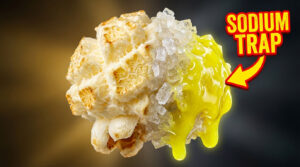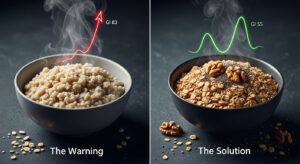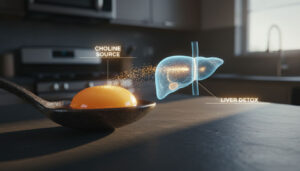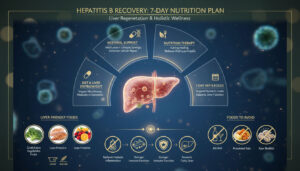You walk into your kitchen, grab a spotted banana from the counter, and peel it. It is soft, sweet, and comforting. You likely believe you are making a healthy choice for your body. For most people, a ripe banana is a perfectly nutritious snack that provides quick energy and potassium. However, if you are one of the millions of Americans managing a fatty liver, that brown banana might be fueling the very fire you are trying to extinguish.
Key Takeaway: Ripe brown bananas contain high levels of fructose (often exceeding 17g per 100g), which drives liver fat creation. Patients with Fatty Liver (MASLD) should switch to Green Bananas. These contain resistant starch to heal the gut and lower triglycerides.
Table of Contents
The common advice to “eat more fruits and vegetables” is often too broad for patients with Metabolic Dysfunction-Associated Steatotic Liver Disease (MASLD), formerly known as NAFLD. Not all fruits are created equal in the eyes of your liver. The stage of ripeness plays a critical role in how your body metabolizes nutrients.
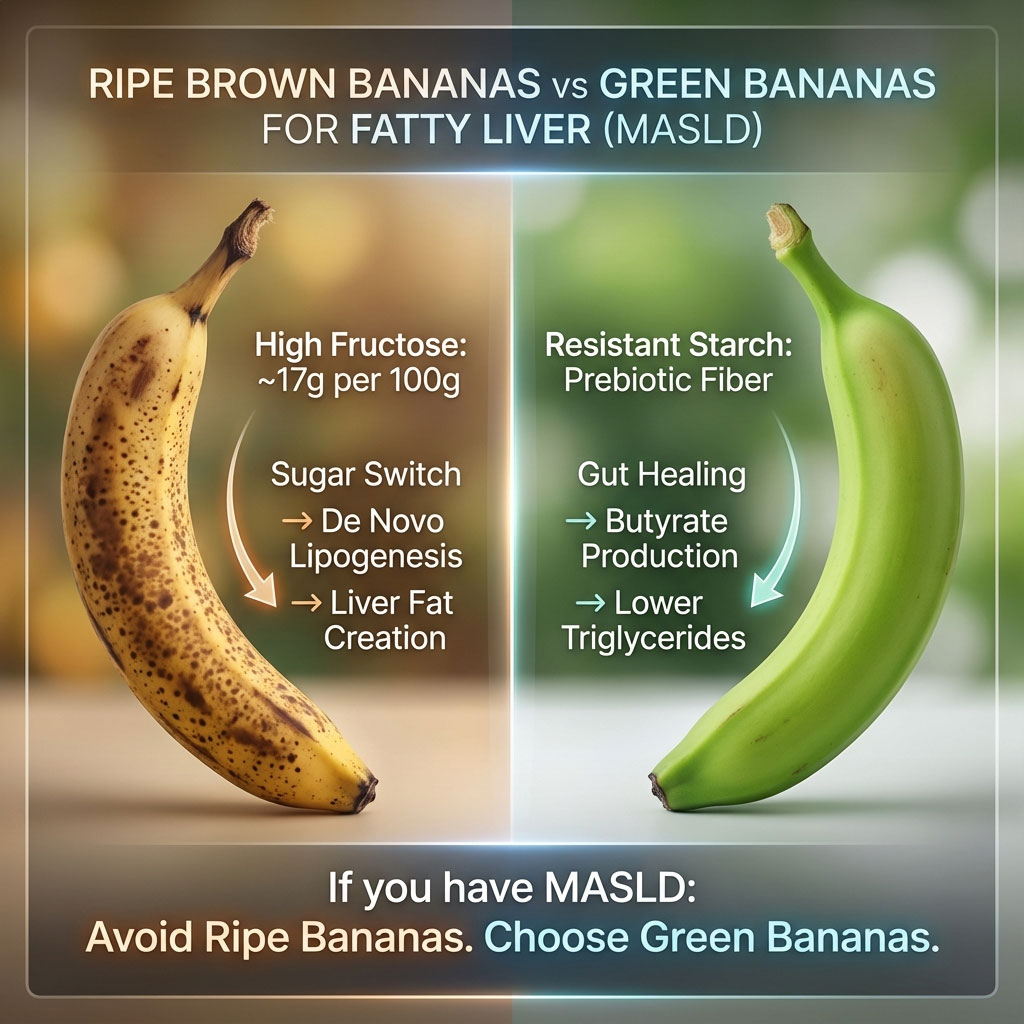
If you have fatty liver disease, you should stop eating brown bananas immediately. As bananas ripen, their beneficial resistant starch undergoes a “sugar switch,” converting into high levels of fructose. This often exceeds 17g per 100g. This excess fructose triggers De Novo Lipogenesis, a biological process where the liver converts sugar directly into fat cells. Instead, you should eat green bananas. They are rich in resistant starch. This prebiotic fiber bypasses digestion, feeds gut bacteria, and produces butyrate to actively reduce liver inflammation and lower triglycerides.
This comprehensive guide will explain the biochemistry behind this phenomenon. It will provide you with a clear roadmap of what to eat to reverse liver fat accumulation, backed by the latest hepatology research.
The “Healthy” Fruit That’s Silently Hurting Your Liver
We are conditioned to believe that fruit is always the answer to health problems. While this is true for heart health or general vitamin intake, liver health requires a specific metabolic approach. The liver is the body’s primary filtration system and metabolic engine. When it is compromised by fat accumulation, it loses the ability to process simple sugars efficiently.
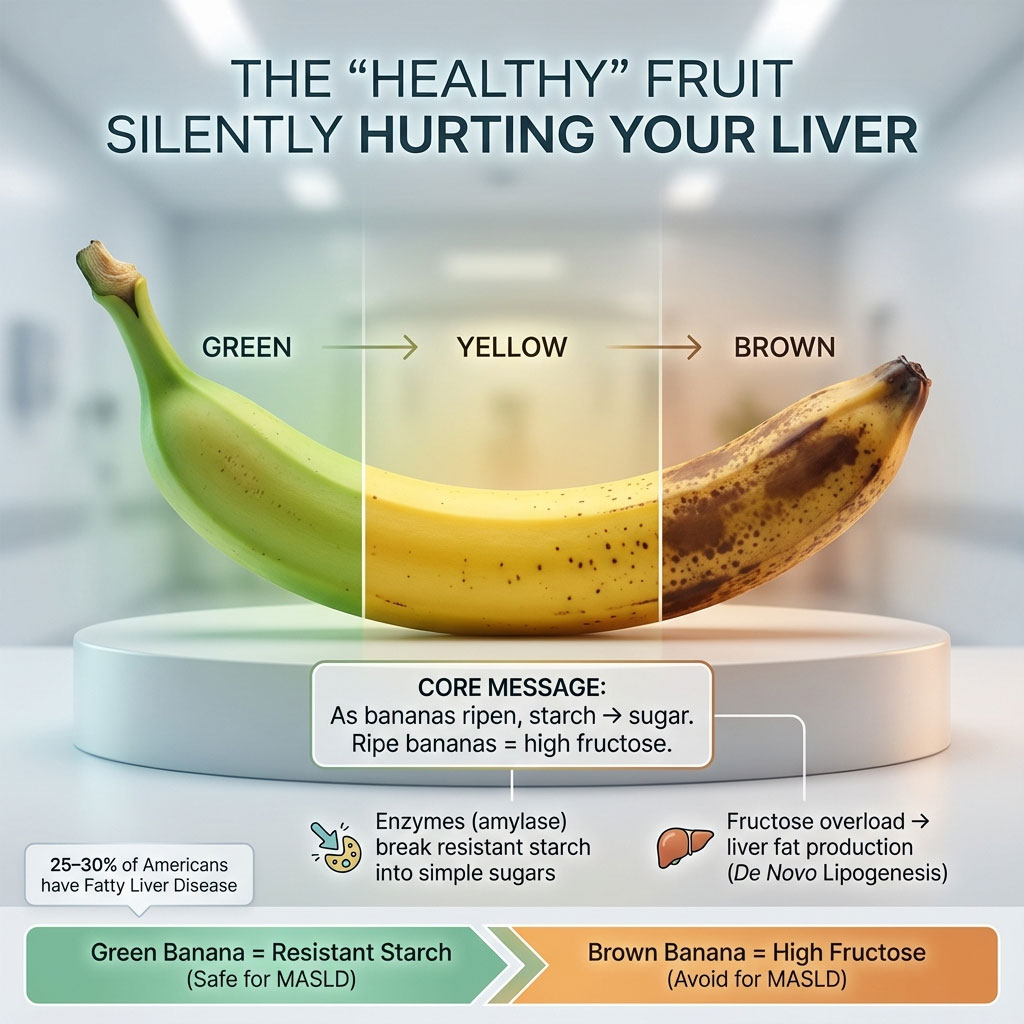
Bananas fatty liver issues arise not because the fruit itself is inherently “bad,” but because of how its chemical composition changes over time. A banana sitting on your counter is a chemistry lab in action. It is constantly breaking down long chains of starch into simple molecules of sugar through the action of enzymes like amylase.
For a healthy individual with high insulin sensitivity, this sugar rush is manageable. The body utilizes the glucose for energy or stores it as glycogen in the muscles. However, for a patient on a fatty liver diet protocol, the specific type of sugar found in ripe fruit poses a unique and often overlooked danger. That sugar is fructose. Understanding this distinction is the first step toward reclaiming your liver health.
The Scale of the Problem
It is estimated that nearly 25% to 30% of the United States population is affected by some form of fatty liver disease. It is a silent epidemic. Most people do not know they have it until routine blood work shows elevated enzymes or an ultrasound reveals hepatic steatosis. In this context, dietary precision becomes paramount. You cannot afford to consume foods that actively work against your liver’s recovery mechanisms. Brown bananas fall into that category of foods that seem innocent but are metabolically counterproductive.
The “Sugar Switch” & Fructose Toxicity
To understand why a brown banana is dangerous for your condition, we must look at the biochemistry of ripening. This process is often referred to by nutritionists and food scientists as the “sugar switch.”
Understanding the Biochemistry of Ripening

When a banana is green, it is biologically designed to be unpalatable to predators so the seeds can mature. At this stage, it is composed of 70% to 80% resistant starch. This starch is structurally complex. It is a long chain of glucose molecules that are tightly bound together. Because of this structure, it does not break down into sugar in the stomach or the small intestine. It acts more like a fiber than a carbohydrate.
As the banana releases ethylene gas, it triggers a ripening cascade. Research documented in the Journal of Agricultural and Food Chemistry highlights how enzymes are activated that attack this starch structure. They chop the long chains into smaller and smaller pieces. By the time the peel turns yellow with brown spots, that 80% starch content has plummeted to less than 1% resistant starch. The rest has converted into glucose, sucrose, and a significant amount of fructose. The fructose in ripe bananas becomes highly concentrated.
Why Fructose Acts Like Alcohol in the Liver
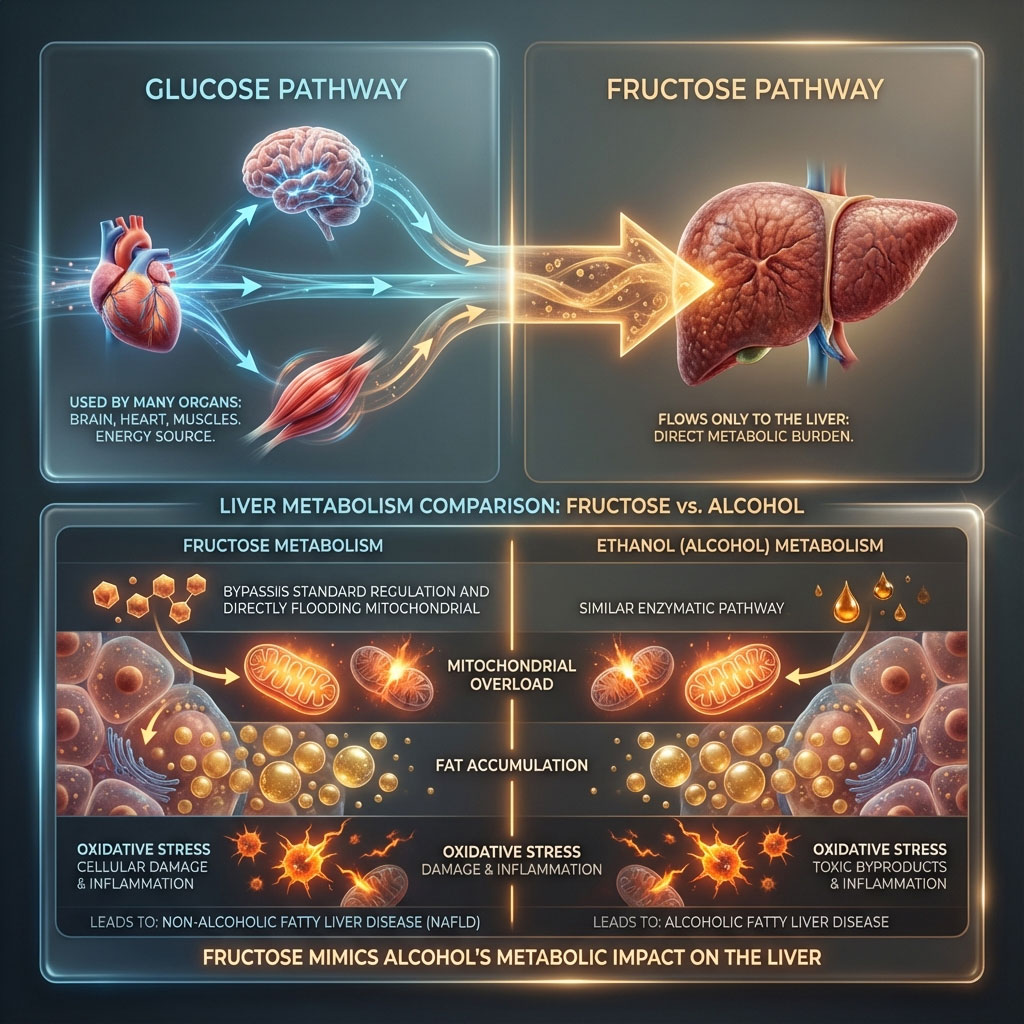
This is where the biology gets fascinating and frightening for a liver patient. Glucose can be metabolized by virtually every cell in your body. Your muscles use it for movement. Your brain uses it for thinking. Your heart uses it to beat. If you eat glucose, your body has many places to put it.
Fructose is different. It is metabolized almost exclusively by the liver.
When you consume a brown banana, you are flooding your system with fructose. Since your muscles cannot use it directly, your liver has to do all the work. Expert gastroenterologists often compare heavy fructose consumption to alcohol consumption. Both substrates overwhelm the liver mitochondria in similar ways. Ethanol (alcohol) and fructose follow very similar metabolic pathways in the liver. Both promote fat accumulation when consumed in excess. If your liver is already struggling with fatty liver disease, this added workload causes cellular stress and oxidative damage.
De Novo Lipogenesis Explained
When the liver is flooded with more fructose than it can turn into immediate energy, it activates a pathway called De Novo Lipogenesis. This medical term literally translates to “new fat creation.”
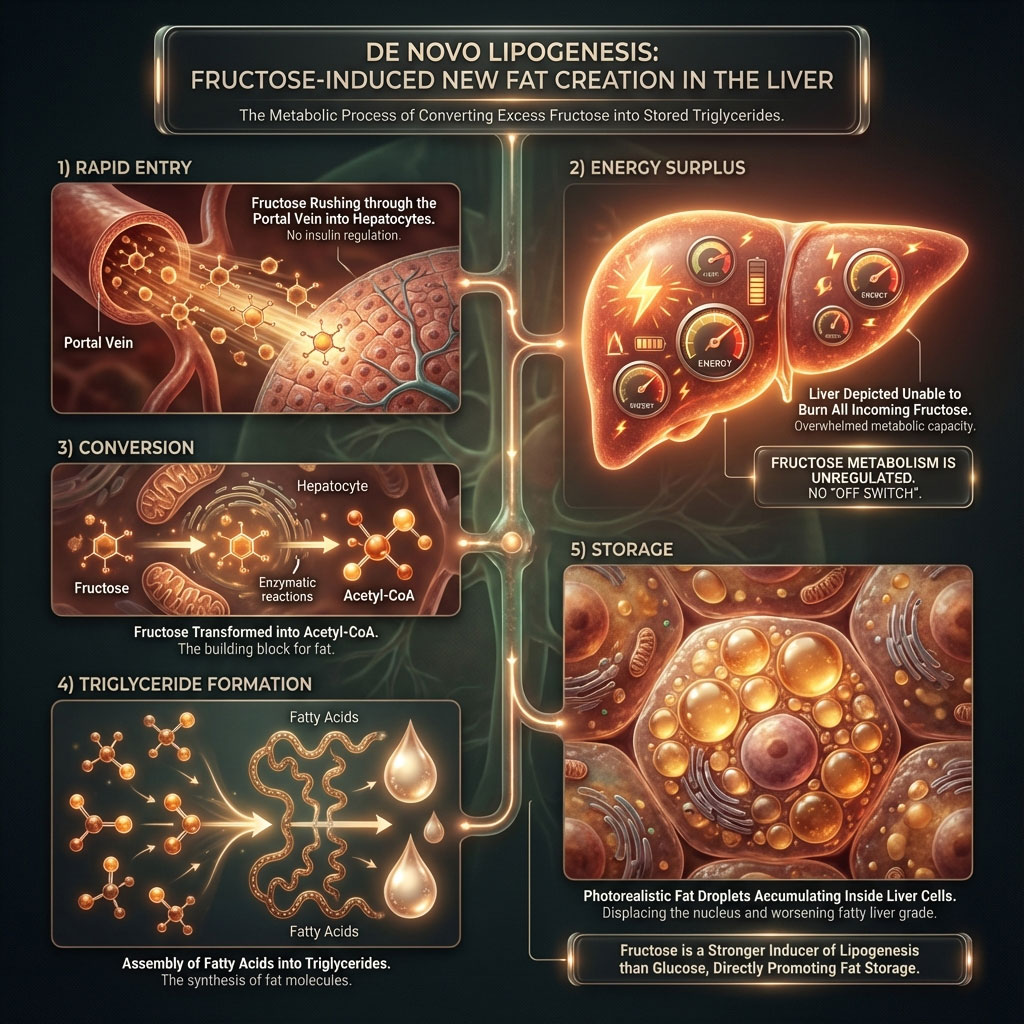
Unlike glucose metabolism, which is tightly regulated by cellular energy needs, fructose metabolism in the liver is largely unregulated. There is no “off switch.” If fructose enters the liver, the liver must process it. Research published in The Journal of Clinical Investigation has demonstrated that fructose is a more potent inducer of lipogenesis than glucose.
Here is the step-by-step process of destruction:
- Rapid Entry: High levels of fructose enter the hepatocytes (liver cells) via the portal vein.
- Energy Surplus: The liver cannot burn it all for fuel because the body’s energy needs are already met.
- Conversion: The liver converts the excess fructose substrate into Acetyl-CoA, which is the building block of fatty acids.
- Triglyceride Formation: These fatty acids are packaged into triglycerides.
- Storage: These fat droplets remain trapped inside the liver cells, displacing the nucleus and worsening the fatty liver grade.
This process directly contributes to liver fat reduction failure. You might be cutting calories. You might be avoiding bread and pasta. But if those calories are replaced with high-fructose ripe bananas, you are inadvertently signaling your liver to store more fat through this lipogenic pathway.
The Uric Acid Connection
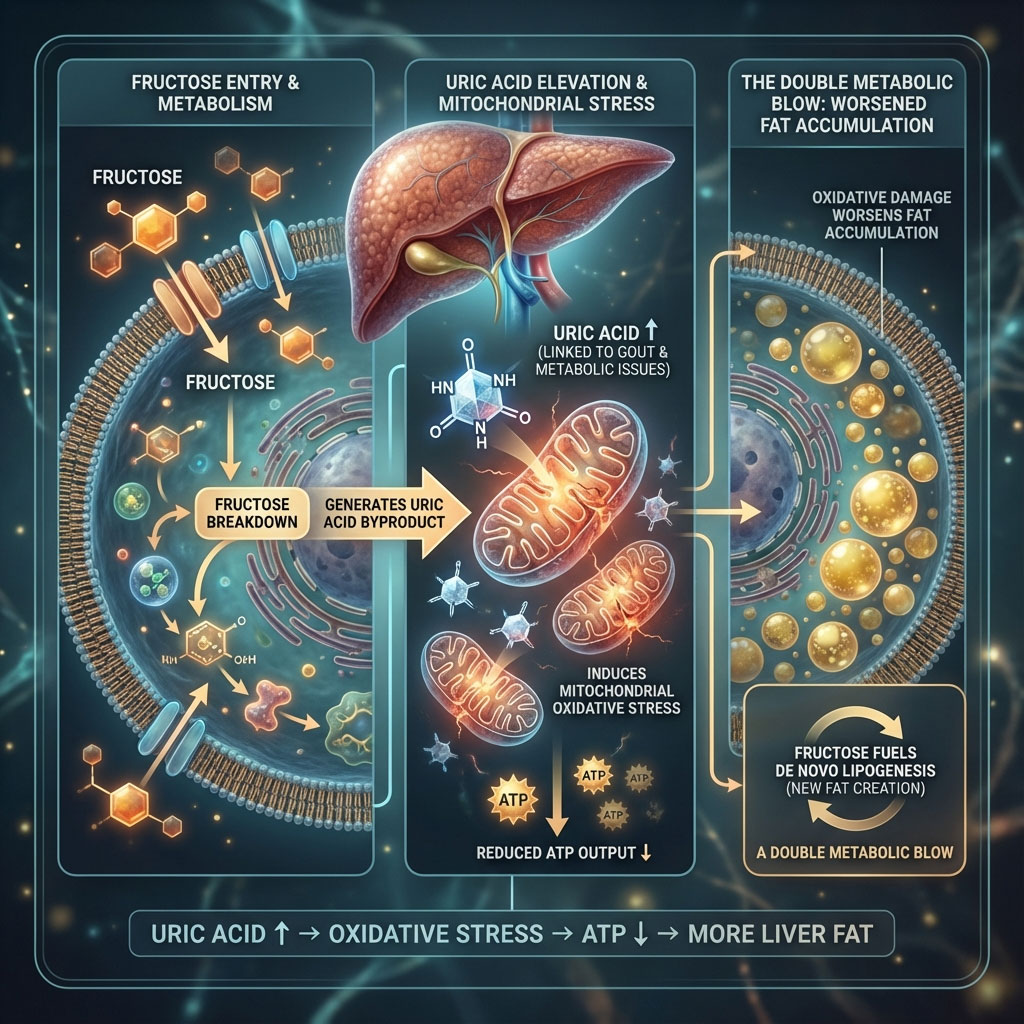
Another side effect of fructose metabolism is the production of uric acid as a byproduct. High uric acid levels are not just a risk factor for gout. They also induce mitochondrial oxidative stress in liver cells. This stress further promotes fat accumulation and can deplete the liver’s stores of ATP (energy). Therefore, the brown banana hits the liver with a double blow: it provides the raw material for fat creation and creates a toxic byproduct that damages the cellular machinery needed to burn fat.
Deep Dive: Why Green Bananas Are a Medical “Superfood”
If brown bananas are the villain in this story, green bananas are the unsung hero. It may seem strange to eat an unripe fruit. They are firm, not very sweet, and starchy. But for fatty liver disease diet management, green bananas are a powerful therapeutic tool.
The Power of Resistant Starch (Type 2)
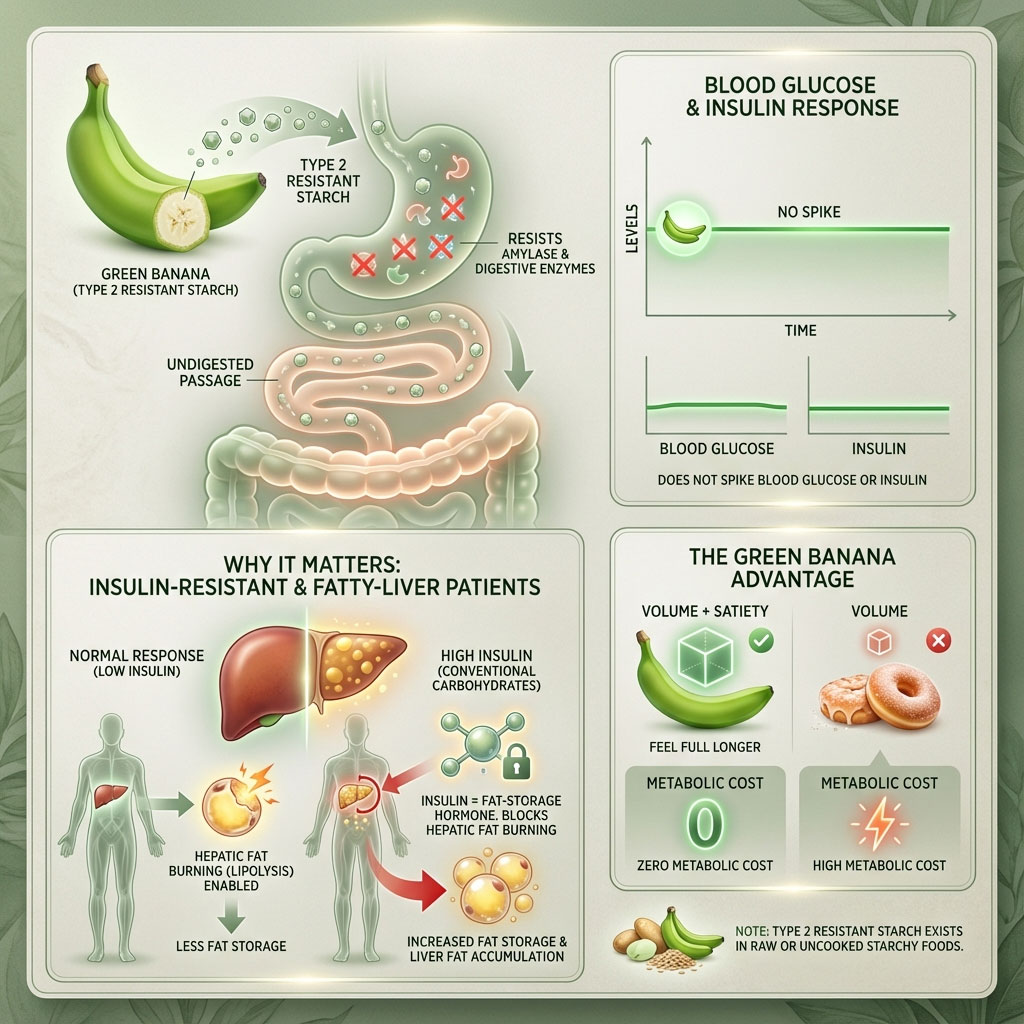
Resistant starch gets its name because it “resists” digestion. It passes through your stomach and small intestine without being broken down by amylase. This means it does not spike your blood sugar or insulin levels.
For a patient with insulin resistance, which is the root cause of most fatty liver cases, this is crucial. Insulin is the fat-storage hormone. High levels of insulin block the liver from burning fat. By eating green bananas, you get the volume and satisfaction of eating food without the metabolic cost of an insulin spike. Green bananas specifically contain Type 2 resistant starch, which is found in starchy foods that are raw or uncooked.
The Gut-Liver Axis Connection
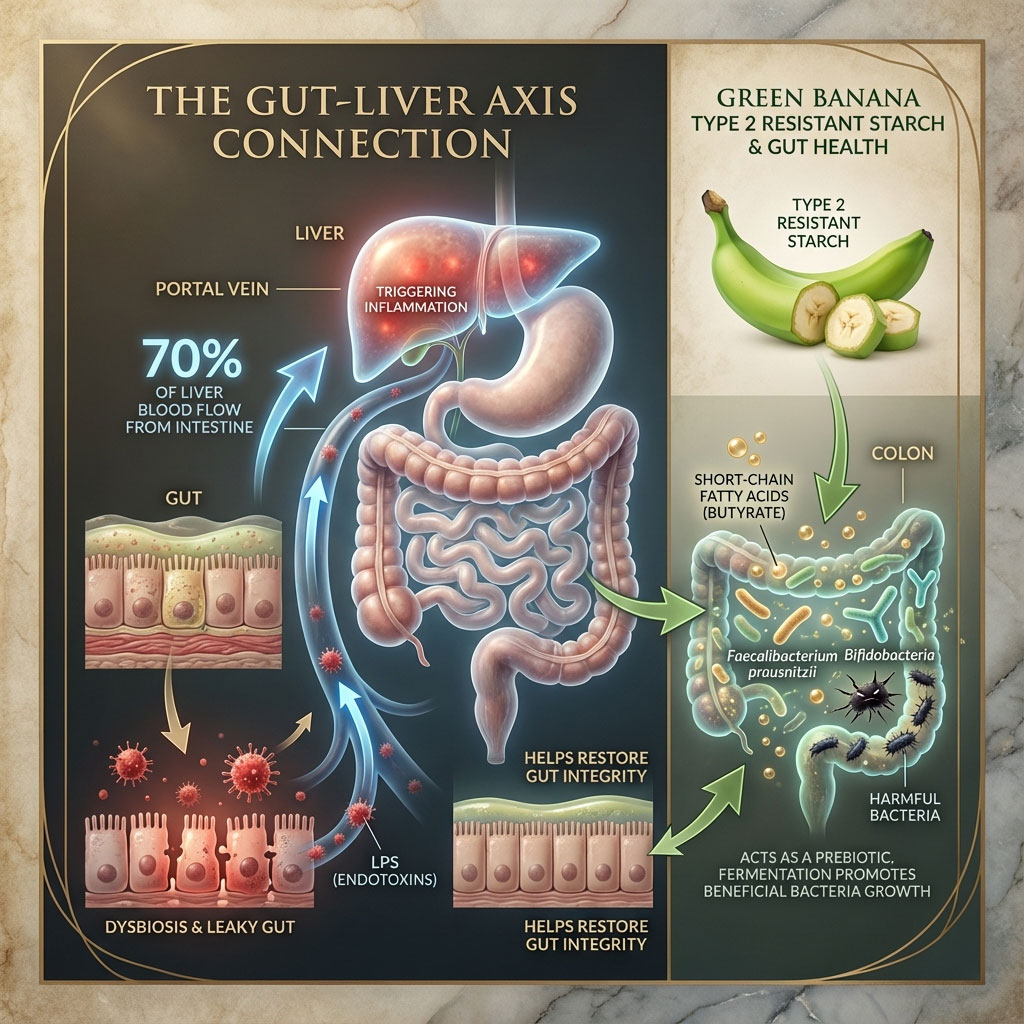
Science has recently discovered a profound link between the health of your gut microbiome and the health of your liver. This is called the gut-liver axis. The liver receives 70% of its blood supply directly from the intestine via the portal vein. This means whatever happens in your gut affects your liver immediately.
If you have a fatty liver, you likely also have some degree of dysbiosis, an imbalance of gut bacteria. This can lead to a condition often called “leaky gut,” where the intestinal barrier becomes permeable. This allows bacterial endotoxins, specifically Lipopolysaccharides (LPS), to leak into the bloodstream and travel to the liver. These toxins cause massive inflammation in the liver.
The resistant starch in green bananas acts as a powerful prebiotic. When it reaches your colon intact, it becomes food for beneficial bacteria like Faecalibacterium prausnitzii and Bifidobacteria. These bacteria ferment the starch and multiply, crowding out the bad bacteria that cause leaky gut.
How Butyrate Burns Liver Fat
The fermentation process in the gut produces Short-Chain Fatty Acids (SCFA). The most important of these for liver health is butyrate. Butyrate is a signaling molecule that travels from the gut to the liver and exerts profound medicinal effects.
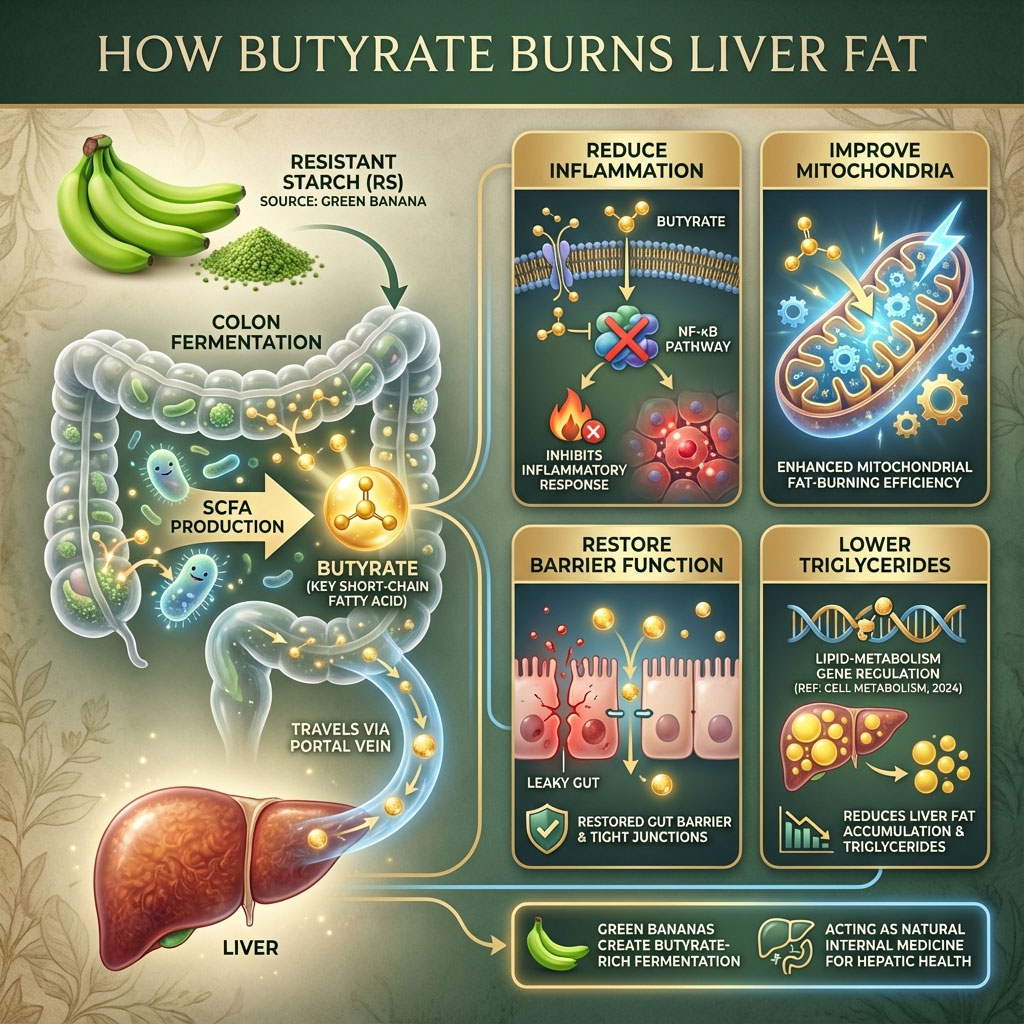
Research published in Cell Metabolism (2024) indicates that resistant starch can significantly reduce liver triglycerides in patients with NAFLD. The study highlights that butyrate can:
- Reduce Inflammation: It inhibits the NF-kappaB pathway, which is the master switch for inflammation in the liver.
- Improve Mitochondria: It helps the liver cells burn fat for energy more efficiently.
- Restore Barrier Function: It serves as the primary fuel source for the cells lining the colon, helping to seal a leaky gut and stop the flow of toxins to the liver.
- Lower Triglycerides: It regulates lipid metabolism genes, leading to lower overall liver fat.
By choosing green bananas, you are essentially creating a natural medicine inside your own gut that helps heal your liver from the inside out.
Comparison: Nutritional Impact of Banana Ripeness
The table below illustrates exactly why the ripeness of the banana matters for your fatty liver diet. The differences are not minor; they represent a complete metabolic shift.
| Nutrient / Factor | Green Banana (Unripe) | Brown Banana (Overripe) |
| Primary Carbohydrate | Resistant Starch (70-80%) | Free Sugars (Glucose/Fructose) |
| Sugar Content (per 100g) | Low (<6g) | Very High (>17g) |
| Glycemic Index (GI) | Low (~30) | High (~60+) |
| Impact on Insulin | Minimal (Stabilizes blood sugar) | High (Spikes insulin) |
| Gut Microbiome Effect | Prebiotic (Feeds good bacteria) | Neutral / Can feed bad bacteria |
| Liver Fat Mechanism | Promotes fat burning (via Butyrate) | Promotes fat storage (Lipogenesis) |
| Digestion Speed | Slow (Sustained Energy) | Rapid (Energy Crash) |
| Fructose Load | Negligible | Significant |
Expert Consensus & Recent Medical Insights (MASLD Context)
The medical community is increasingly vocal about the role of diet in managing liver disease. The terminology itself is shifting to reflect this. We are moving away from vaguely blaming “fat” and looking at metabolic dysfunction.
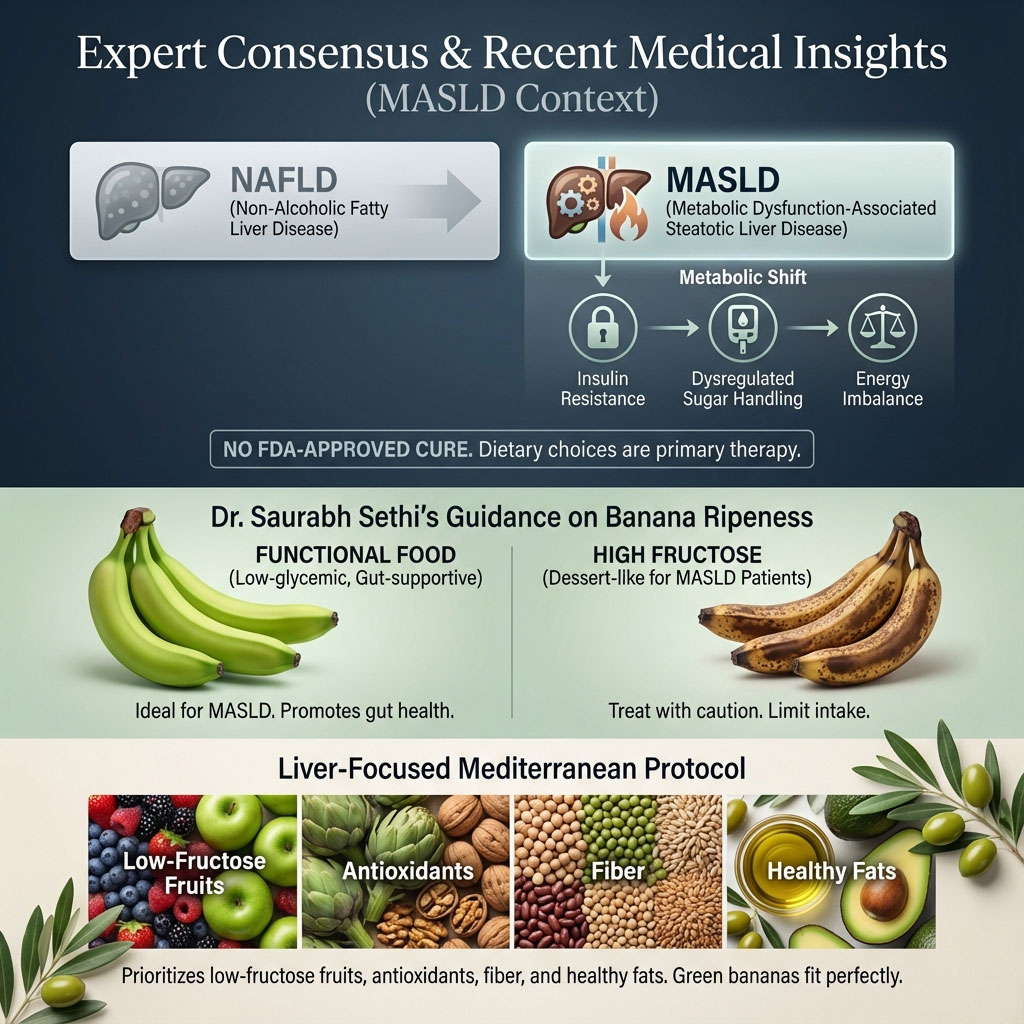
From NAFLD to MASLD: Why the Name Change Matters
You may have been diagnosed with NAFLD (Nonalcoholic Fatty Liver Disease). However, recently, liver specialists and global associations like the AASLD have renamed the condition MASLD (Metabolic Dysfunction-Associated Steatotic Liver Disease).
Why does this matter for your banana choice? The new name emphasizes “metabolic dysfunction.” This confirms that the disease is driven by how your body processes energy, sugar, and fat. It is inextricably linked to insulin resistance, obesity, and type 2 diabetes. It reinforces why dietary choices like avoiding brown bananas are the primary treatment. There is no FDA-approved pill to cure fatty liver yet. Food is the medicine. The shift in terminology puts the focus squarely on controlling blood sugar and insulin, which brown bananas notoriously disrupt.
Dr. Saurabh Sethi’s Verdict on Bananas
Prominent experts are now using social platforms to educate patients on these nuances. Dr. Saurabh Sethi, a Harvard and Stanford-trained gastroenterologist, has explicitly discussed the differences in banana ripeness.
Dr. Sethi and other experts note that while fruit is natural, the concentration of fructose in overripe fruit makes it counterproductive for liver patients. They recommend adhering to MASLD diet recommendations that prioritize low-glycemic foods. The consensus among metabolic health experts is clear: are green bananas better for fatty liver? Yes, unequivocally. They categorize green bananas as a functional food for gut health, while brown bananas are categorized similarly to a dessert.
The Mediterranean Protocol for Fruit
The Mediterranean diet is currently considered the gold standard for reverse fatty liver strategies. However, a “liver-focused” Mediterranean approach differs slightly from the standard version you might see in a magazine.
While the standard diet encourages all fruits, the liver-modified protocol restricts high-fructose tropical fruits. It leans heavily on fruits that provide antioxidants without the sugar load. It emphasizes the consumption of healthy monounsaturated fats (like olive oil) alongside fiber sources. Green bananas fit this protocol perfectly because they are high in fiber and low in sugar.
“Eat This Instead”: The Ultimate Liver-Friendly Fruit Guide
If you cannot stomach the taste of green bananas, or if you simply want variety, you are not out of luck. There are several liver friendly fruits that you can eat daily to support liver fat reduction.
The goal is to find fruits low in fructose but high in polyphenols and antioxidants. These compounds help repair liver cells and reduce fibrosis (scarring).
Berries: The Antioxidant Powerhouses
If you need a sweet treat, reach for blueberries, raspberries, or blackberries. These fruits are rich in anthocyanins, the pigment that gives them their dark color.

Anthocyanins are powerful antioxidants that have been shown to reduce oxidative stress in the liver. A study published in the journal Nutrients found that regular consumption of anthocyanin-rich foods attenuated liver steatosis and inflammation. They help prevent the liver cells from becoming scarred. Furthermore, berries have a very low glycemic index. A cup of raspberries has more fiber than sugar. This means they will not trigger the insulin spike that leads to fat storage. Blueberries specifically contain pterostilbene, a compound structurally similar to resveratrol, which has been linked to enhanced fat metabolism in the liver.
Citrus Fruits: Natural Fat Burners
Grapefruit and lemons are excellent additions to a fatty liver diet. They contain a compound called naringenin.
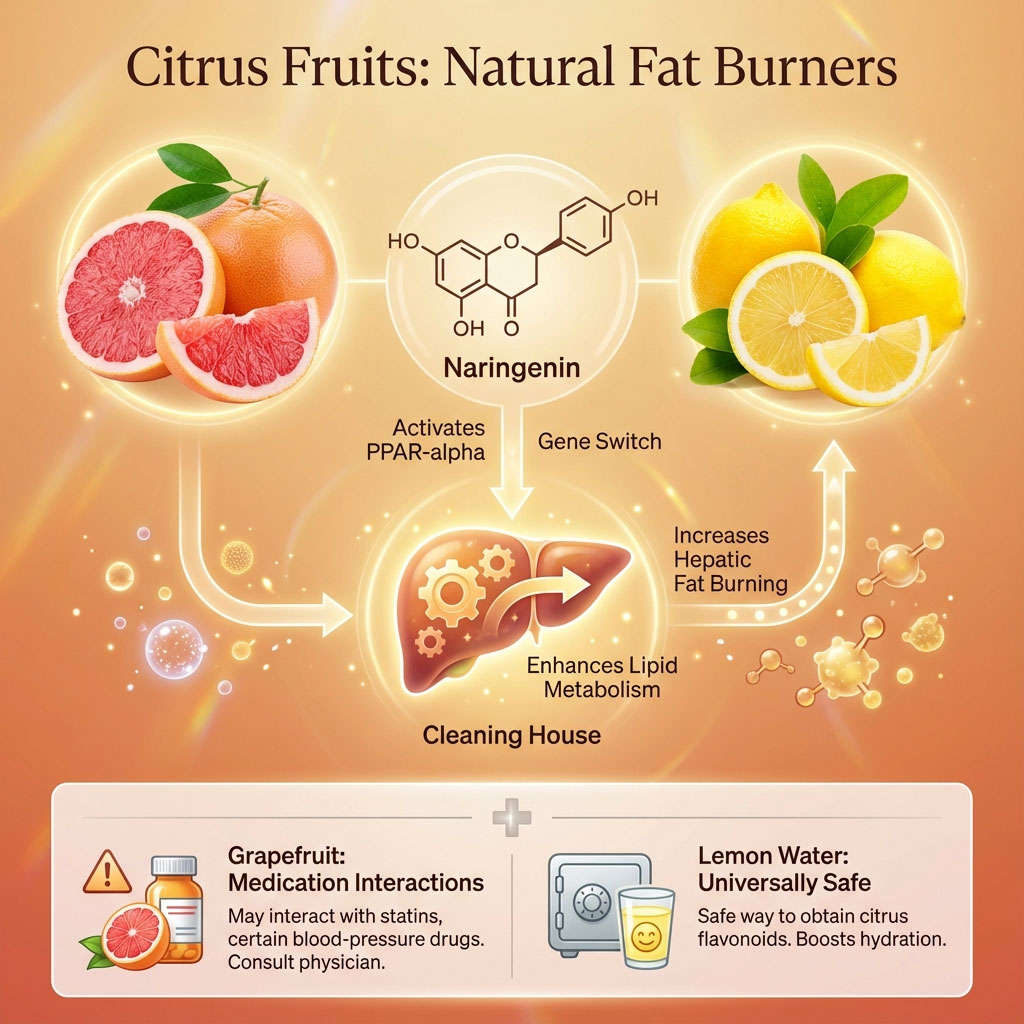
Naringenin acts like a switch that turns on the genes responsible for burning fat in the liver. It essentially helps the liver “clean house” by activating the PPAR-alpha pathway, which regulates lipid metabolism. However, always check with your doctor regarding grapefruit, as it can interact with certain medications (like statins or blood pressure drugs). Lemon water is a safer alternative for everyone and provides a gentle way to consume these flavonoids.
Avocado: The Healthy Fat Shield
Avocados are technically a fruit, and they are perhaps the best fruit for liver health. They are low in sugar and high in healthy monounsaturated fats.
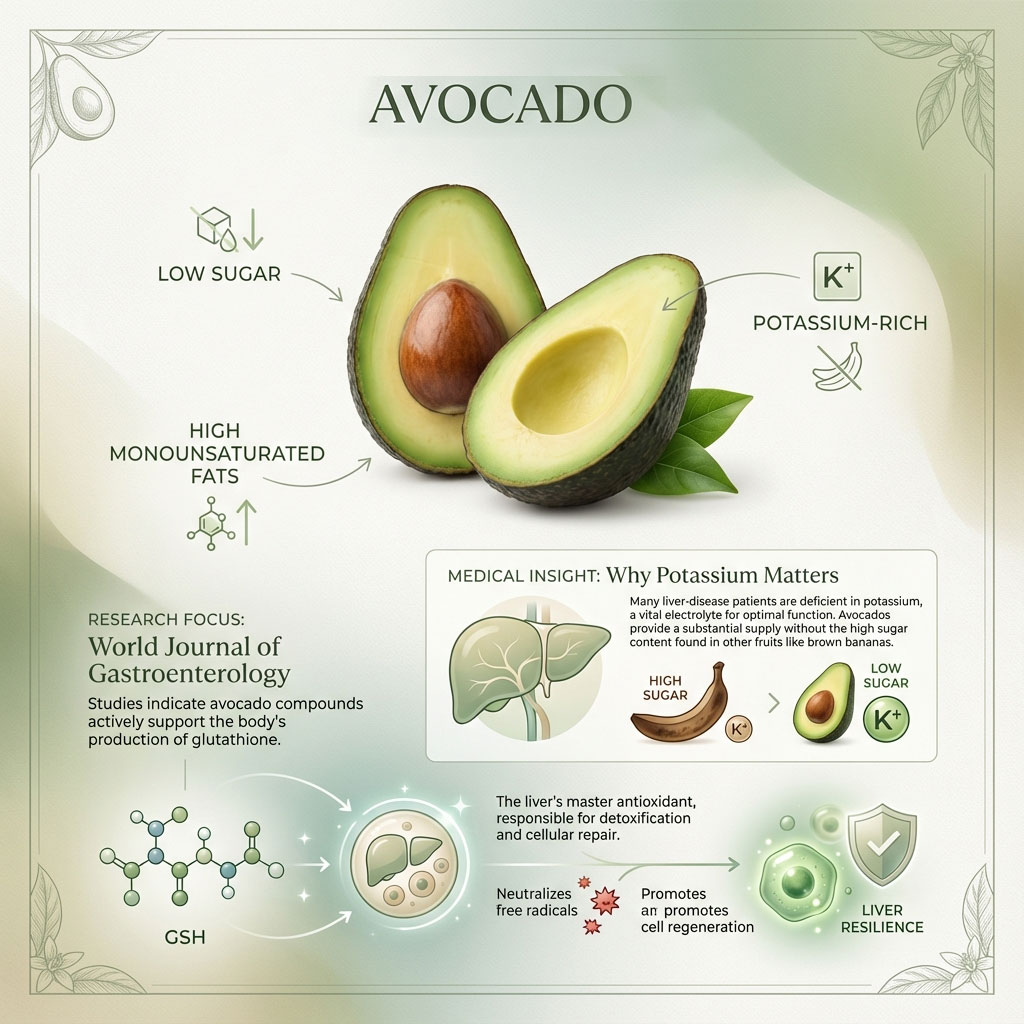
More importantly, avocados are rich in potassium. Many patients with liver disease are deficient in potassium. While bananas are famous for potassium, the sugar cost of a brown banana is too high. Avocados provide that potassium with zero sugar. Additionally, research published in the World Journal of Gastroenterology suggests that avocados contain compounds that may help the body produce glutathione. Glutathione is the body’s master antioxidant and is essential for the liver to filter out toxins and repair itself.
Papaya: The Digestion Aid
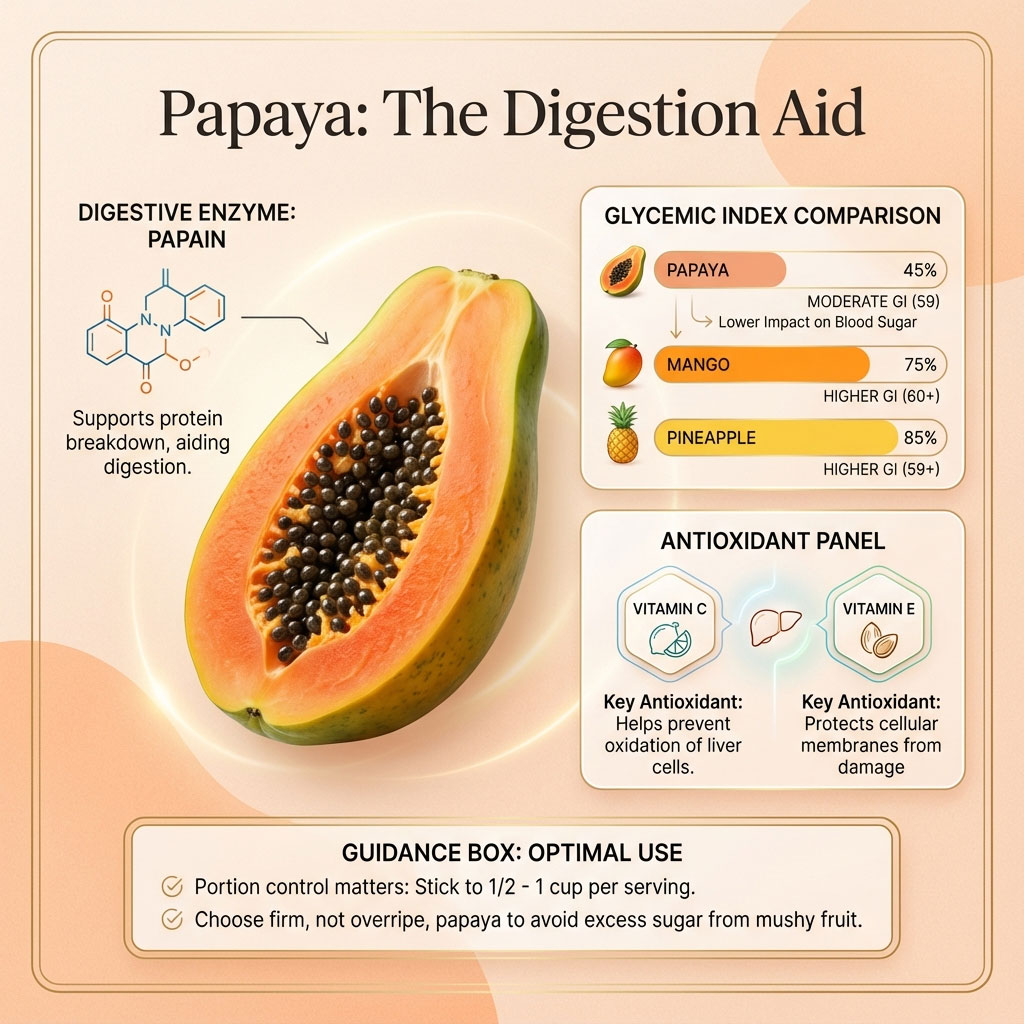
Papaya contains enzymes like papain which aid in protein digestion. It also has a moderate glycemic index compared to other tropical fruits like mangoes or pineapples. It is rich in vitamins C and E, which are antioxidants that stop liver cells from oxidizing. The key with papaya is portion control and ensuring it is not overripe to the point of mushiness.
Go vs. No-Go Fruit List for MASLD
Use this guide to make quick decisions at the grocery store.
| Category | Fruits Included | Impact on Liver | Key Compound |
| Best (Eat Daily) | Green Bananas, Blueberries, Raspberries, Avocados, Lemons, Limes | Reduces inflammation & fat | Resistant Starch, Anthocyanins, Naringenin, Glutathione support |
| Moderate (Limit) | Green Apples, Pears, Papaya, Oranges, Kiwi, Plums | Neutral in moderation | Pectin, Vitamin C |
| Avoid (Stop) | Brown Bananas, Mangoes, Grapes, Cherries, Dried Fruits (Raisins/Dates), Canned Fruit in Syrup | Increases fat storage (DNL) | Concentrated Fructose, High Glycemic Load |
Practical Strategies: How to Eat Green Bananas (Without Hating Them)
One of the biggest hurdles to adopting green bananas is the taste and texture. They are chalky, astringent, and the peel is very hard to remove. You cannot simply peel and eat them like a ripe banana. You have to shift your mindset and treat them more like a vegetable, similar to a potato.

Method 1: The Boiled Method (Caribbean Style)
In many cultures, specifically in the Caribbean and parts of Asia, green bananas are a staple food known as “provisions.”
- Prep: Wash the green bananas thoroughly. Cut off both ends.
- Score: Take a knife and make a shallow slit down the length of the banana skin, being careful not to cut deep into the flesh.
- Boil: Place them in a pot of boiling salted water. Keep the skins on. Boil for 15 to 20 minutes.
- Peel: Remove them from the water. The peel will have turned black, but the fruit inside will be firm and creamy. The peel will slide off easily now.
- Serve: The fruit inside becomes soft and tastes very similar to a potato or a dumpling. You can mash it with a little olive oil, garlic, and sea salt. This makes for a perfect, liver-friendly side dish packed with resistant starch.
Method 2: Green Banana Flour
If you absolutely cannot cook them, look for green banana flour (or plantain flour) in health food stores. This flour is made by drying unripe bananas and grinding them.
- How to use: You can add a tablespoon of this to your morning oatmeal or yogurt.
- Baking: You can use it as a gluten-free flour substitute in baking.
- Benefit: It provides all the resistant starch green bananas benefits without the hassle of cooking or peeling.
Method 3: Pickled Green Bananas
Some cuisines pickle green bananas. The vinegar helps break down the chalky texture and adds probiotic benefits. The acetic acid in vinegar has also been shown to improve insulin sensitivity, making this a double win for the gut-liver axis.
Essential Tip: Do Not Fry Them
While green plantains are often fried to make “tostones,” frying involves submerging them in hot oil. If you use inflammatory seed oils like soybean, corn, or canola oil, you negate the anti-inflammatory benefits of the banana. If you must crisp them up, use an air fryer with a light spray of avocado oil.
The Liquid Sugar Trap: Smoothies and Juices
A common mistake people make when trying to get healthy is buying a high-speed blender. They throw in three or four ripe bananas, some orange juice, and maybe some yogurt to make a morning smoothie. It is crucial to distinguish between green smoothies and fruit-heavy smoothies.

Green Vegetable Smoothies:
Smoothies made primarily of spinach, kale, cucumber, and lemon with a small amount of low-glycemic berries are generally safe and beneficial. These provide essential micronutrients without the sugar load.
Fruit-Heavy Smoothies:
Are smoothies with bananas harmful for fatty liver? Yes, if they are fruit-dominant. When you blend a ripe banana or other high-sugar fruits, you destroy the fiber matrix. Even though the fiber is technically still in the blender, it has been mechanically pulverized. This means your body does not have to do any work to digest it.
The sugar in that fruit-heavy smoothie hits your liver instantly. It is a tsunami of liquid fructose. This causes a massive spike in insulin and forces the liver into immediate De Novo Lipogenesis. It bypasses the body’s satiety signals. You can drink five bananas in a smoothie and feel hungry an hour later. If you ate five bananas, you would be full for hours.
The rule for fatty liver diet success is simple: Eat your fruit, do not drink it. Chewing creates satiety signals and stimulates the release of incretin hormones, which help regulate insulin. It slows down the absorption of sugar, giving your liver a chance to keep up.
Real Expectations: The Timeline of Reversal
Patients often ask how long it takes to see results. It can be discouraging to change your diet and not see the scale move immediately. However, liver health improves before weight loss becomes visible. The liver is the only organ in the human body capable of true regeneration.
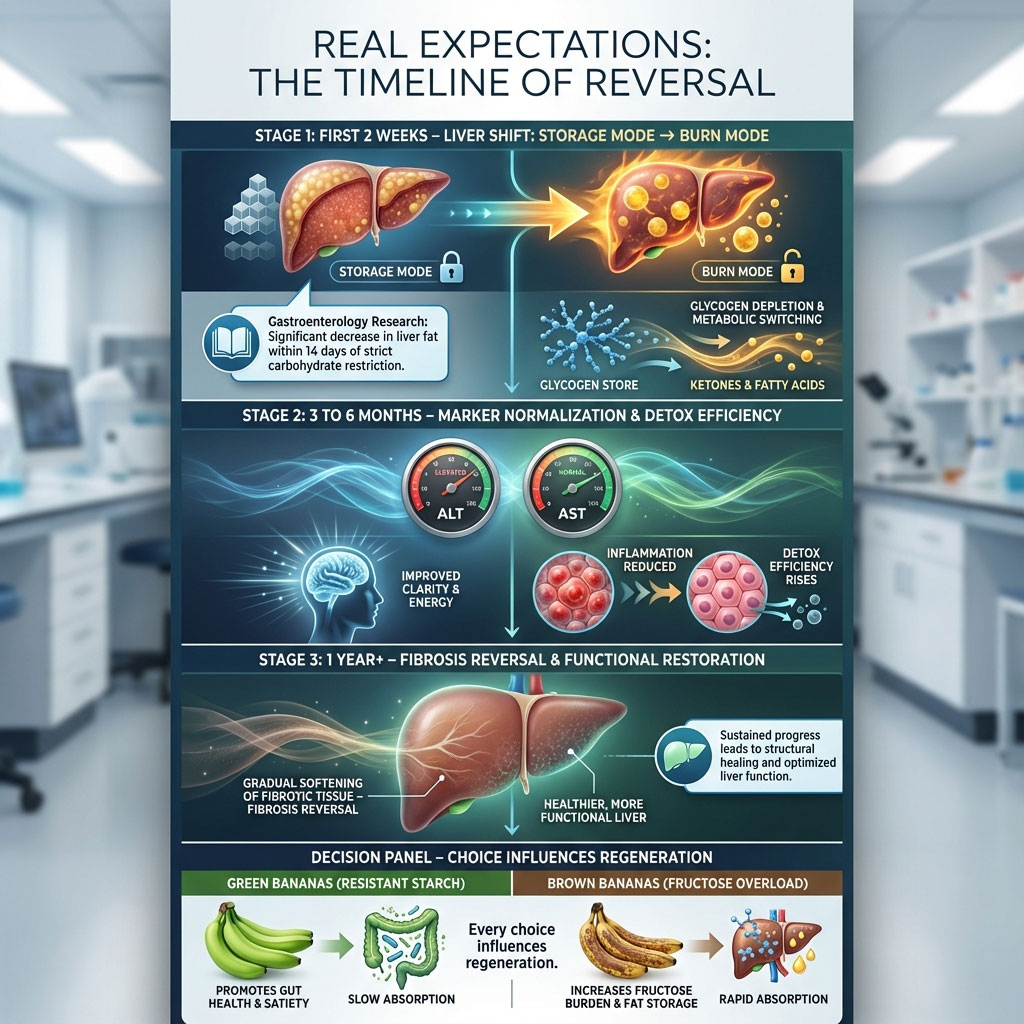
If you stop eating brown bananas and other high-fructose foods, and switch to green bananas and low-carb vegetables, you can see changes rapidly.
The First 2 Weeks
Research published in Gastroenterology has shown that liver fat can begin to decrease significantly within just 14 days of strict carbohydrate restriction. You might not see it on the scale yet, but the biochemical changes in the liver are happening. Glycogen stores are being depleted, and the liver is switching from “storage mode” to “burn mode.”
3 to 6 Months
With consistent adherence to a fatty liver diet that avoids foods to avoid with fatty liver, enzyme levels (ALT and AST) often return to normal ranges. Inflammation decreases. You may notice increased energy levels and better mental clarity as your liver becomes more efficient at detoxifying the blood.
1 Year and Beyond
Significant fibrosis (scarring) can begin to reverse. The liver tissue becomes softer and more functional.
It is a marathon, not a sprint. But every time you choose a green banana over a brown one, you are making a conscious choice to heal your liver. You are choosing to feed your gut bacteria rather than feeding the fat cells in your liver.
Summary & Key Takeaways
Reversing fatty liver disease requires a shift in how we view “healthy” foods. Metabolic health is about controlling insulin and reducing the workload on the liver.

- Stop Eating Brown Bananas: They are sugar bombs that trigger fat creation in the liver via fructose overload.
- Start Eating Green Bananas: They are rich in resistant starch, which feeds good gut bacteria and signals the liver to burn fat.
- Choose Alternatives: If you dislike green bananas, opt for berries, avocados, and citrus fruits.
- Avoid Liquid Sugar: Fruit-heavy smoothies with ripe fruit are dangerous for MASLD patients; stick to green vegetable smoothies or whole fruit.
- Consistency is Key: Your liver is resilient. Give it the right fuel, and it can repair itself.
By understanding the sugar switch, you empower yourself to make dietary decisions that actively support your recovery. You are moving from passive consumption to active management of your health.
Frequently Asked Questions (FAQs)
Is it okay to eat bananas if you have fatty liver disease?
Yes, but the ripeness is the deciding factor. You can eat green bananas or bananas that are barely yellow with green tips. You should strictly avoid fully brown or spotted bananas because the sugar content is too high for a compromised liver to handle efficiently. Green bananas provide resistant starch which helps reduce liver fat.
Why are brown bananas worse than green bananas for the liver?
It comes down to the “sugar switch.” Brown bananas have converted almost all their starch into free sugars, specifically fructose. This high fructose load forces the liver to create new fat cells (De Novo Lipogenesis). Green bananas contain resistant starch, which aids in liver fat reduction by improving gut health and lowering insulin spikes.
What is the single worst fruit for fatty liver?
Dried fruits like raisins, dates, and dried cranberries are arguably the worst. They are dehydrated, which concentrates the sugar density. Among fresh fruits, overripe mangoes and brown bananas are top offenders due to their high fructose content and rapid absorption rates. Consuming these can undo days of healthy eating.
Can resistant starch from green bananas reverse fatty liver?
While no single food is a miracle cure, resistant starch is a powerful tool. It improves the gut-liver axis by producing butyrate, a compound that reduces liver inflammation and improves insulin sensitivity. When combined with a proper fatty liver diet, it significantly aids in reversal and metabolic repair.
How much fructose is safe for a fatty liver patient per day?
Most experts recommend keeping total fructose intake below 15 to 20 grams per day for those looking to reverse fatty liver. A single large brown banana can contain nearly this entire limit, leaving no room for other foods. Vegetables should be your primary carbohydrate source, and fruit should be treated as a treat, not a staple.
Are smoothies with bananas harmful for fatty liver?
Yes, typically. Blending ruptures the fiber cells in the fruit. This allows the sugar to hit your bloodstream and liver much faster than if you chewed the fruit. This rapid spike promotes fat storage. Green vegetable smoothies (kale, spinach, lemon) are safe, but fruit-heavy smoothies should be avoided.
What is the best breakfast for someone with MASLD?
A high-protein, high-fiber breakfast is best. Consider eggs with avocado and a side of boiled green bananas (as a potato substitute) or berries. This combination keeps insulin levels low and provides sustained energy without stressing the liver. Avoiding sugary cereals, toast, and juice is critical.
Does lemon water reduce liver fat?
Lemon water is helpful but not a cure-all. It promotes hydration, which is vital for liver function, and provides Vitamin C and naringenin, which help reduce oxidative stress. It is a perfect replacement for sugary juices or sodas in a fatty liver diet, but it must be paired with dietary changes to see results.
Is plantain good for fatty liver?
Yes, green plantains are excellent. They are very similar to green bananas and are packed with resistant starch. However, they must be prepared correctly; boiled, baked, or roasted. Frying them in inflammatory seed oils (like vegetable or canola oil) negates their health benefits.
How long does it take to reduce liver fat with diet?
With strict adherence to a low-sugar, low-fructose diet, you can see a reduction in liver fat in as little as two weeks. However, normalizing liver enzymes and reversing inflammation typically takes 3 to 6 months of consistent healthy eating. Full reversal of fibrosis can take a year or more.
Do I have to stop eating fruit completely?
No. You need to stop eating high-sugar fruit. Liver friendly fruits like raspberries, blackberries, strawberries, and avocados are full of nutrients that help repair the liver. The goal is to avoid the fructose spike, not the fruit itself. Fruit provides essential vitamins and minerals that synthetic supplements cannot replicate.
What does Dr. Sethi recommend for fatty liver diet?
Dr. Saurabh Sethi and other leading gastroenterologists often recommend a combination of the Mediterranean diet and intermittent fasting. This approach emphasizes healthy fats (olive oil, avocado), lean proteins, and low-glycemic fruits, while giving the liver a break from digestion for 12 to 16 hours a day. This fasting window allows the liver to focus on cellular repair rather than digestion.
Disclaimer: This content is for informational purposes only and does not constitute medical advice, diagnosis, or treatment. Always consult with your hepatologist, gastroenterologist, or qualified healthcare provider before making drastic changes to your diet, especially if you have advanced liver disease or are taking medication.


